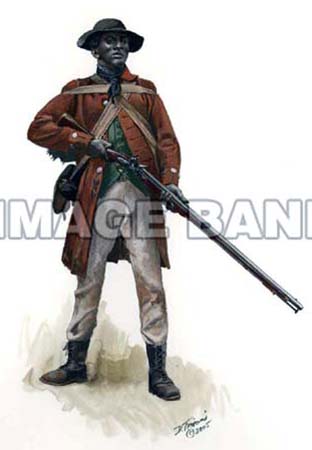The year 1783 would be one of nearly continuous reductions, reorganizations and unit re-designations. As news, both official and unofficial, of the nearing of peace reached America, the Congress responded by ordering the ongoing contractions of the army. The first day of the new year once again brought the now fully familiar annual reduction. The ever-essential Massachusetts Line remained the largest, being reduced from ten regiments to eight. Its mainstay sister of the Connecticut Line, reduced to only five regiments under the 1781 establishment, now emerged with but three. The once-grand Pennsylvania Line, which had exceeded fifteen regiments between 1777 and 1780, had been virtually destroyed by the Morristown mutiny and its bureaucratic mishandling and now remained as only three regiments. Particularly targeted for virtual elimination were the lines serving in the Southern Department. The Delaware Regiment was furloughed with the new year, and the Maryland Line was reduced from three regiments to one. The remnant of the once-grand Virginia Line had met virtual elimination, being captured at the disastrous surrender of Charlestown in 1780 and now disappearing entirely with the disbanding of its single regiment at Fort Pitt (current Pittsburgh). The North Carolina Line was similarly slashed from four regiments to only one.
Only two months later, a second contraction affected the remaining states’ units. Each of these included the differentiation of the battalion, now having a variant meaning from that which the term had had in 1775. Now, a battalion was, essentially, a “demi-regiment”, being designed to reduce a unit below the normal regimental size. The long-traditioned 1st New Hampshire Regiment became The New Hampshire Regiment, while the old 2nd Regiment became The New Hampshire Battalion. The Rhode Island Regiment of 1781 was re-designated The Rhode Island Battalion, while the same two modifications made in the New Hampshire Line were made in that of New Jersey. Only three weeks following these March 1 modifications, the final remaining North Carolina regiment was furloughed. Thus, the army that had been ferried in November 1782 to New Windsor, north of West Point, for its final winter cantonment numbered only about 10,200 officers and men present for duty by the following March.
From as early as the mid-summer of 1782, rumors of peace were rife throughout the army. As each proved false, this process of hope and disappointment only added to the boredom and frustration typically associated with the inactivity of a winter cantonment. Even “make busy” projects such as the construction of a major causeway crossing low wetland bisecting the New Windsor camp and of a large meeting hall called the “Temple of Virtue” could not absorb all of the pent-up energy, frustration and irritation of the troops. As to the latter, nearly all the men were at least a year in arrears as to their wages and resultantly had little faith in either the Congress or their home states for restitution. As 1783 progressed, and the rumors of peace became more frequent and apparently believable, the long constrained tensions and animosities increased. In March, the army’s officers corps was brought to intense agitation and to the brink of a coup D’etat by the appearance of two anonymous circulars calling for a final confrontation with the Congress. (For a more thorough discussion of this critical phase of the Revolution, click on this link for “the Newburgh Conspiracy.”)
The General Orders of April 19 issued by the commander -- timed eight years to the day following the Lexington/Concord eruption -- brought the long-awaited announcement of peace. The camp along the Hudson burst forth with rejoicing and celebration, inclusive of a fireworks display such as most of the men had never before seen. Now, more so than previously demonstrated, all cries were for payment and discharge. Whatever feelings of celebration and goodwill, if any, remained by the end of May were immediately consumed in rage upon receipt of the Congress’ final plans for the army. Based on the interpretation that the treaty of peace with Great Britain yet needed to be approved by the Parliament, the Congress resolved that officers and the rank and file were to be furloughed, not discharged, until such time as the final treaty was ratified. If the British reneged and hostilities again emerged, the troops would be called back to service. When this resolution was interpreted with the accompanying one that the men were to receive no more than a month’s back wages in currency, the remainder to be provided for in promissory notes redeemable over time, the furlough was considered a total ruse to avoid payment. The reaction at New Windsor was predictable outrage, as recorded in the May 31 diary entry of Private Thomas Foster, 7th Massachusetts Regiment:
“This day a tumult is begun on account of the during the war men
having furloughs instead of the discharges which they are justly
entitled to by their first enlistment, as that specified that we were
at the end of the contest to be free. And, now to only furlough us
and not to pay us is an odd unheard of piece of injustice and not
to be put up with by brave men that have fought and suffered
everything but the dissolution of soul and body. For they have
never been paid according to contract but been most shamefully
deceived and baffled almost in every article of contract made with
them and now to be sent into the country naked and destitute of
money and almost everything else is what you may call an injury to
them, to their poor families and an equal disgrace to the continent
that they under God have made free.
Within less than two weeks following this diary entry, the New Windsor huts were virtually abandoned. As a token of the country’s gratitude, the men were permitted to retain their muskets and accouterments, even this gesture having been at the suggestion of General Washington. Thus, the individual state lines of the “for the war men” were marched away from the Hudson Highlands toward home, under the command of their officers to prevent any irregularities or demonstrations while carrying arms. As each crossroads was reached, small groups separated off toward their own home towns. After eight years of service under the most extraordinary deprivations, the army had no final grand review; no welcoming parades awaited the men upon their arrivals. The great bulk of the Continental Army simply faded away during the first half of June. In mid-November after the receipt of unquestionable confirmation of the final treaty with Great Britain being signed, these men were discharged.
The remnant of the force that remained past early June was comprised of men who had enlisted for three years after 1780 and those whose even shorter-term enlistments were yet unexpired, these troops being marched from New Windsor to West Point in late June. The two New Hampshire units were consolidated into the single New Hampshire Regiment at this time and served until finally disbanded on January 1, 1784. From the prior eight Massachusetts regiments, the shorter-term enlistment men were, also in June, reformed into four regiments of the line, these units serving until mid-to late-December. The remaining short-term men of the Rhode Island Battalion continued under that designation until being disbanded on Christmas Day at Saratoga. The for-the-war men in the five Connecticut Line units were furloughed in early June, the remaining short-term enlistment men being consolidated into the 3rd Connecticut which was re-designated The Connecticut Regiment. This regiment served until the end of December. From these troops at West Point came the force that accompanied Major General Robert Howe to Philadelphia to put down a second mutiny of the Pennsylvania Line, and to establish martial law at the request of Governor George Clinton in New York following the evacuation of that city by General Carleton. After seven years of its occupation by the enemy, the city was reclaimed by General Washington and the minute American army on November 25, 1783.
Beginning as early as May 1783, proposals and counter-proposals had been exchanged between General Washington and the Congress as to a peacetime military establishment. Although the general’s initial plan was for a permanent army of very modest size, it exceeded the desires of the ever cost-conscious legislators. In early December, Washington ordered Major General Henry Knox to discharge all but 500 infantry and 100 artillerymen. Once again, remaining enlistment times determined the troops to be discharged and those to be retained in service. Those men from New Hampshire and Massachusetts with the longest remaining times became Colonel Henry Jackson’s Continental Regiment. This tiny force of the last Continentals remained at West Point throughout the winter that followed, but in June 1784 the Congress ordered the discharges of all remaining troops excepting 55 caretakers at West Point and 25 at Fort Pitt. In the same month, Congress developed its own design for the post-war military, consisting of a total of 700 men to be enlisted for one year, this quota being allotted to the states of Connecticut, New York, New Jersey and Pennsylvania. Commanded by Josiah Harmar, this unit would be designated The First American Regiment, the seedling of the United States Army.



